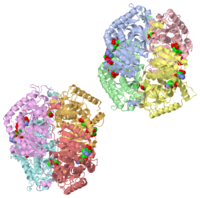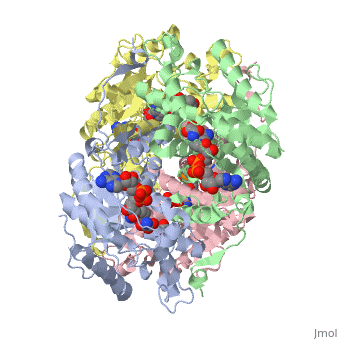Jasper Small Lactate Sandbox 1

HUMAN MUSCLE L-LACTATE DEHYDROGENASE M CHAIN, TERNARY COMPLEX WITH NADH AND OXAMATEHUMAN MUSCLE L-LACTATE DEHYDROGENASE M CHAIN, TERNARY COMPLEX WITH NADH AND OXAMATE
Lactate DehydrogenaseLactate Dehydrogenase
Lactate Dehydrogenase (LDH) is an important enzyme in humans. It occurs in different regions of the body, each region having a unique conformation of different subunits. The Jmole image shown is that of LDH-5, the form found in skeleton muscle and the liver.
FunctionFunction

LDH preforms an important metabolic function in the body. The enzyme catalyzes both the conversion of pyruvate to lactose as well as the conversion of lactose to pyruvate. The conversion of pyruvate to lactose occurs in the muscles of the body when oxygen is absent. The lactate acid is then moved back to the liver where LDH catalyzes the Cori cycle which converts the lactose back into pyruvate. The reaction is also important as it is coupled with the interconversion of NADH and NAD+.
DiseaseDisease
Known disease associated with this structure: Exertional myoglobinuria due to deficiency of LDH-A OMIM:[150000]
About this StructureAbout this Structure
1I10 is a 8 chains structure of sequences from Homo sapiens. Full crystallographic information is available from OCA.
ReferenceReference
Page seeded by OCA on Tue Feb 17 09:19:04 2009

